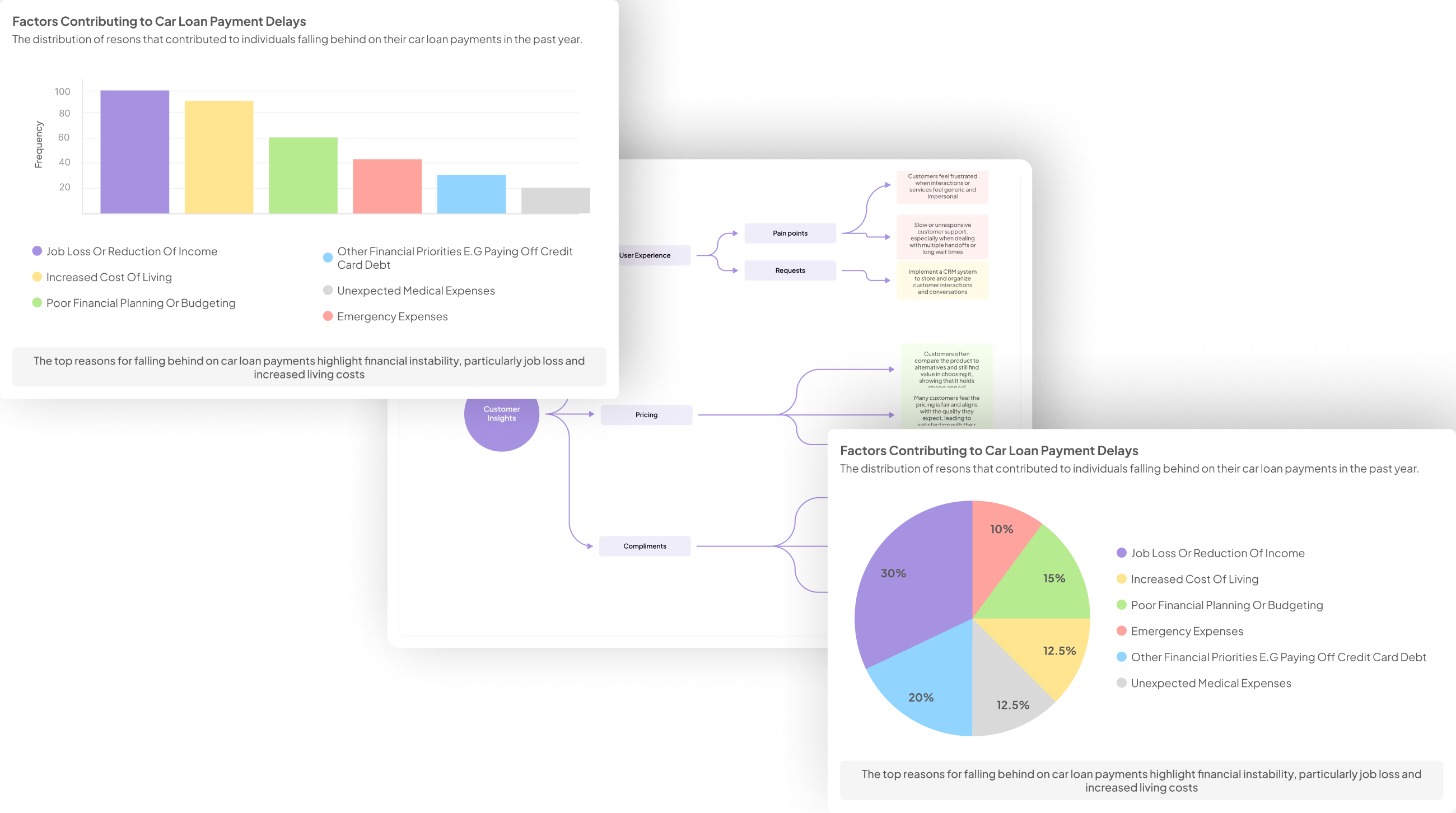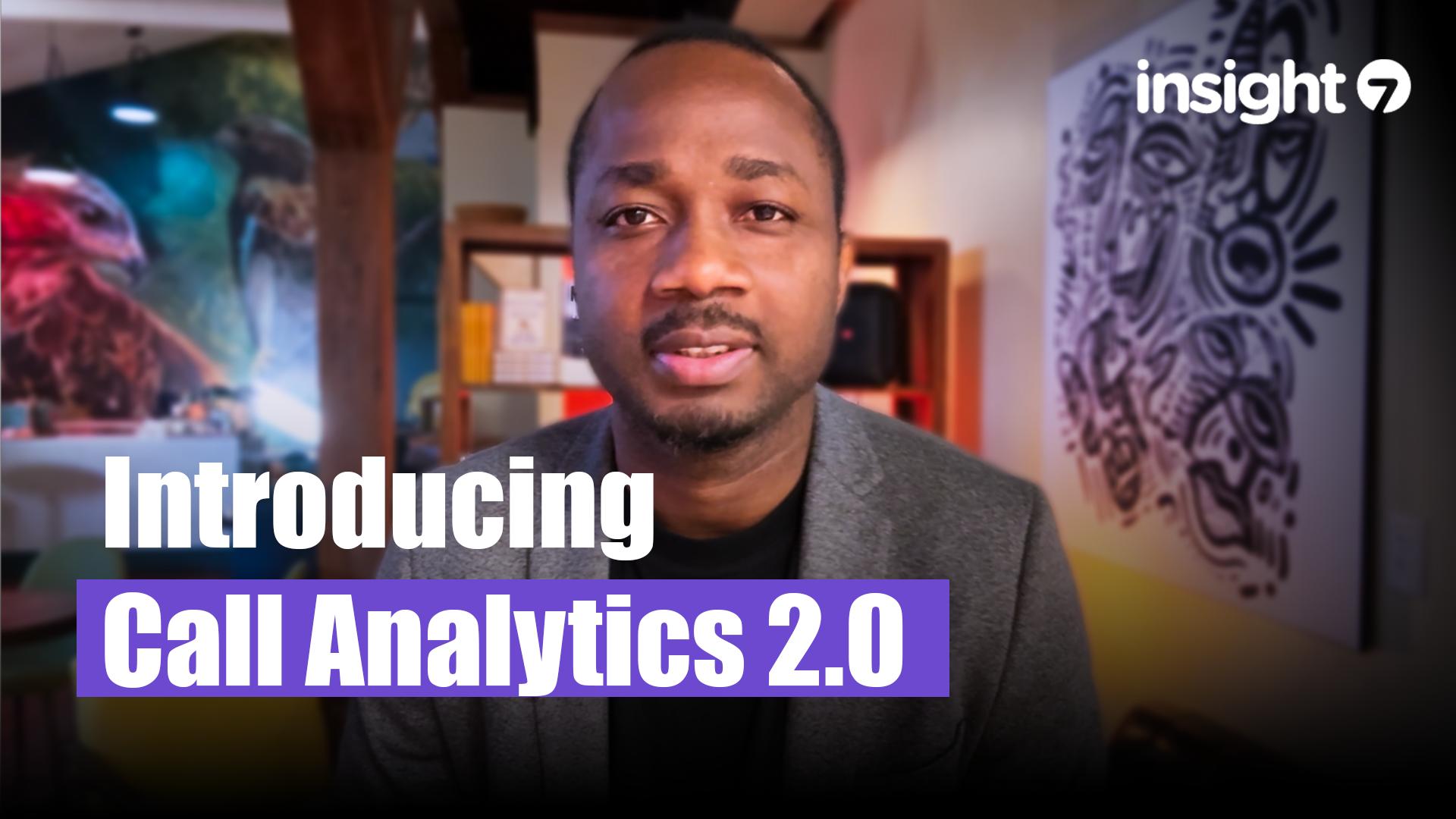Best AI tools for visualizing insights from buyer calls
-
Bella Williams
- 10 min read
Buyer Call Visuals present a powerful opportunity to transform conversations into actionable insights. By effectively utilizing AI tools, businesses can analyze buyer interactions at scale, revealing patterns and pain points previously hidden in raw data. With the ability to transcribe and visualize these calls seamlessly, teams can ensure that every valuable insight from buyer conversations is captured.
Visualizations derived from buyer calls enhance comprehension and facilitate decision-making. They allow teams to identify key themes, summarize crucial information, and support strategic planning. The integration of these visuals into your workflow will not only streamline the analysis process but also empower stakeholders to leverage buyer insights confidently. Familiarity with these tools can significantly elevate your approach to understanding customer needs and improving engagement outcomes.
Generate visualizations from your qualitative data. At Scale.

Exploring AI Tools for Buyer Call Visuals
Buyer Call Visuals provide vital insights that can reshape your understanding of customer feedback. As we delve into AI tools designed for visualizing these insights, we discover a powerful resource for businesses. These tools can analyze qualitative data from calls, breaking down comments into categories such as positive, negative, and neutral. By utilizing advanced algorithms, businesses can uncover trends and patterns that may not seem apparent at first.
The exploration of AI technologies enables users to query large datasets more efficiently. You can compare insights across different locations or product lines, allowing for strategic adjustments based on direct customer input. Integrating these tools into your workflow not only enhances clarity but also fosters a data-driven culture. Effective use of Buyer Call Visuals ensures that the voice of the customer shapes organizational strategies, ultimately driving success.
Insight7: Leading the Way in Buyer Call Visualization
In the evolving realm of buyer call visualization, innovative AI tools play a pivotal role. Companies today are inundated with a wealth of customer conversation data, yet traditional analysis methods often struggle to keep pace. This is where advanced buyer call visuals come into play. They transform raw dialogue into actionable insights, enhancing understanding and decision-making. By effectively visualizing these interactions, businesses can swiftly adapt their strategies to meet customer needs, ensuring they stay competitive in a dynamic marketplace.
The integration of AI-fueled platforms streamlines the analysis process, converting time-consuming manual efforts into efficient workflows. Teams can pinpoint key customer signals, streamline collaboration, and ultimately drive meaningful actions based on real insights. With the ability to visualize buyer calls, organizations can foster engagement, ask better questions, and recommend tailored solutions that resonate with customers. Embracing these tools empowers businesses to not only respond effectively but also anticipate and fulfill customer expectations.
Other Essential AI Tools for Buyer Call Visuals
While some AI tools are exceptional for visualizing buyer call insights, additional essential options can enhance your analysis significantly. First, consider using advanced transcription tools. These tools convert conversation audio into text quickly and accurately, allowing for efficient data extraction. Being able to retrieve key details and sentiments expressed during buyer calls can sharpen your understanding of customer needs.
Next, text analytics tools can provide deeper insights. They go beyond basic transcription, analyzing sentiment, keywords, and themes that emerge from the calls. This allows teams to identify patterns in customer feedback and preferences. Furthermore, visualization tools enable teams to create engaging dashboards and reports that make it easier to present insights to stakeholders. By integrating these tools into your workflow, you can elevate the effectiveness of your buyer call visuals and support more informed decision-making strategies.
- Tool 2
Choosing the right AI tool for visualizing insights from buyer calls can significantly enhance your understanding and decision-making process. Tool 2 stands out with its ability to transform raw data into clear, actionable visuals. Through intuitive dashboards and comprehensive reporting features, it allows users to easily identify trends and patterns in buyer behavior. This tool also simplifies collaboration, enabling teams to share insights quickly and efficiently.
Integrating Tool 2 into your workflow can streamline your buyer call analysis. Importing call recordings and transcripts is straightforward, making it easy to extract meaningful insights. Additionally, its customizable templates ensure that the visuals align with your specific needs, enhancing both clarity and impact. Utilizing AI-driven visualizations can empower your team to make informed decisions based on actual buyer interactions, ultimately driving better results.
- Tool 3
Tool 3 is designed for businesses seeking to elevate the insights derived from buyer calls. With its advanced analytics capabilities, this AI tool focuses on transforming raw conversation data into clear, actionable buyer call visuals. Users can visualize trends, track customer emotions, and identify key decision-making factors, offering a comprehensive view of interactions.
One of the standout features of Tool 3 is its user-friendly interface, allowing teams to create compelling visuals without requiring extensive technical skills. Additionally, it integrates seamlessly with existing CRM systems, enhancing the utility of historical call data. This tool is ideal for organizations wanting to provide their teams with deeper insights that inform sales strategies and improve communication. By leveraging its capabilities, businesses can foster a better understanding of their customers' needs, ultimately driving more effective client engagements.
- Tool 4
Tool 4 presents an innovative approach to transforming buyer call data into visual insights. This tool specializes in interpreting complex call recordings, extracting key metrics, and presenting them visually for deeper understanding. With its intuitive interface, users can quickly view call trends, track sentiment analysis, and identify actionable insights.
One of the standout features of Tool 4 is its ability to compile data models that visualize customer interactions in real-time. This aspect helps teams make informed decisions based on live feedback and patterns observed in buyer calls. Furthermore, the tool allows for customization, ensuring that the visual representations cater specifically to your organization's needs. Such flexibility enhances not only understanding but also effective communication within teams, ultimately driving better business outcomes. Adopting Tool 4 can significantly elevate the way organizations handle and analyze buyer call insights, making the data far more accessible and actionable.
- Tool 5
Tool 5 offers a powerful solution for transforming buyer calls into impactful visual insights. By utilizing advanced AI algorithms, this tool helps users glean key information from conversations, analyzing speaker tones, and identifying sentiment changes in real-time. This ability to visualize interactions creates a clearer understanding of buyer needs and motivations, which ultimately aids in decision-making.
Furthermore, Tool 5 allows for easy integration into your existing workflow. This means that you can seamlessly import call data and generate comprehensive reports that highlight trends and recurring topics. Such streamlined processes enhance productivity while ensuring that important insights are not overlooked. Ultimately, using Tool 5 can significantly elevate your approach to Buyer Call Visuals, providing clarity and actionable data to improve your business outcomes.
Evaluate Performance on Customer Calls for Quality Assurance.
Implementing Buyer Call Visuals in Your Workflow
Implementing Buyer Call Visuals in your workflow begins by understanding the necessity of streamlined insights from customer interactions. To successfully incorporate these visuals, start by identifying your specific call data needs. This will guide you in selecting the most appropriate tools that can convert raw data into valuable visual insights, enhancing decision-making processes.
Next, choose the right AI tools designed for visualizing buyer calls. These tools must not only transcribe your recordings but also analyze and summarize the data effectively. Once set up, regularly use these tools to visualize trends and derive actionable insights, ensuring your team remains aligned and informed about buyer sentiments. Ultimately, integrating Buyer Call Visuals improves communication and fosters a culture of data-driven decision-making, making your workflow more efficient and responsive to customer needs.
Steps to Integrate AI Tools for Buyer Call Visuals
To effectively integrate AI tools for Buyer Call Visuals, begin by identifying your specific data needs. Consider what insights you want to gather from the calls and how this information will drive your decision-making. By understanding the distinct requirements for your buyer calls, you set a solid foundation for the integration process, ensuring the AI tools selected will effectively meet those goals.
Next, choose an AI tool that aligns not only with your data needs but also integrates seamlessly into your existing workflows. After selecting a tool, take time to set it up and configure it according to your preferences. This may include customizing features to better visualize facts from call transcripts. Finally, analyze the collected data and visualize insights with the AI tool to gain valuable perspectives on your buyer calls. By following these steps, you can unlock actionable insights that drive success in your business.
- Step 1: Identify Your Call Data Needs
To effectively identify your call data needs, start by assessing what information is critical for understanding buyer interactions. Consider the types of insights you wish to gain from your conversations, such as customer pain points, preferences, and feedback. This foundational step helps you set clear objectives for data collection and visualization, ensuring they align with your business goals in enhancing buyer call visuals.
Next, evaluate the specifics of the call data that you require. This includes the volume of calls, the key metrics you want to measure, and any qualitative data that can enrich your analysis. Think about how these elements will inform your strategies and decision-making processes. By thoroughly identifying your call data needs, you set the stage for selecting the most suitable AI tools for visualizing insights, which ultimately transforms your approach to buyer calls.
- Step 2: Choose the Right AI Tool
Selecting the right AI tool for visualizing insights from buyer calls is crucial for your sales strategy. Begin by assessing your specific needs. Consider factors such as the type of data you generate from calls and how you wish to visualize this information. Different tools offer varied functionalities, and a better fit will enhance your analysis process significantly. Ensure the tool aligns with your workflow to maximize efficiency and effectiveness in deriving insights.
Next, evaluate each option’s features. Look for tools that offer customizable dashboards, intuitive interfaces, and robust analytic capabilities specifically suited to buyer call visuals. Additionally, consider the level of support and resources available for each tool, as this can impact your learning curve and user experience. By making an informed choice, you can transform how you visualize and utilize insights from buyer calls, ultimately enhancing decision-making processes within your team.
- Step 3: Set Up and Configure the Tool
Setting up and configuring the tool is a vital step in harnessing the full potential of Buyer Call Visuals. Start by ensuring that you have access to all necessary data sources, such as recorded calls and transcripts. This integration process streamlines importation, making it easy to gather insights and analyze conversations. Configuring user permissions allows your team to pitch in effectively, enabling equal access to insights without requiring specialized software training.
Next, familiarize yourself with the tool’s interface, which should feature intuitive navigation. Explore the functionality that allows you to visualize insights from calls, such as pain points and customer feedback. Comprehensive tutorials or demo sessions can assist in this learning process, reinforcing team competency. Once configured properly, the tool will support your analytical needs, transforming raw data into actionable Buyer Call Visuals, ultimately driving informed decisions.
- Step 4: Analyze and Visualize Insights
To effectively analyze and visualize insights from buyer calls, it is crucial to extract meaningful data that drives your business decisions. Start by collecting and organizing your call data, ensuring that you have clear categories for positive and negative feedback. Identifying trends in these insights helps create a clearer picture of customer preferences and pain points.
Next, utilize AI tools specifically designed for data visualization. These tools can transform raw call data into easy-to-understand charts and graphs. For instance, you can visualize the frequency of certain sentiments expressed in calls. By comparing insights across different datasets, such as calls from various locations, you can uncover patterns that inform your strategic decisions. Engaging with buyer call visuals not only facilitates efficient analysis but also supports more informed decision-making processes within your organization.
Benefits of Using AI for Buyer Call Visuals
Using AI for buyer call visuals offers distinct advantages that enrich the analytical process. First and foremost, AI technology enhances the accuracy of insights drawn from conversations. This level of precision helps businesses make informed decisions based on real data, rather than relying on subjective interpretations. Additionally, AI can identify patterns that may be overlooked by human analysts, enabling a more nuanced understanding of customer needs and behaviors.
Another key benefit is the efficiency of processing large volumes of call data. AI tools automate the analysis, significantly reducing the time required to extract valuable insights. This capability allows teams to dedicate more resources to strategic planning and execution. Overall, integrating AI for buyer call visuals aligns with modern business requirements, providing clarity and actionable intelligence that can drive sales and improve customer satisfaction.
Conclusion on Buyer Call Visuals
Effective Buyer Call Visuals play a crucial role in transforming raw data into actionable insights. By utilizing advanced AI tools, organizations can analyze buyer calls more efficiently, uncovering patterns and sentiments that typically go unnoticed. These visuals not only summarize feedback but also help teams to identify key areas for improvement and innovation.
In conclusion, investing in the right AI tools for visualizing buyer call insights leads to enhanced decision-making and strategic planning. Companies that embrace these technologies will likely stay ahead of the competition by continuously adapting to customer needs and preferences, ensuring long-term success in a dynamic market.







